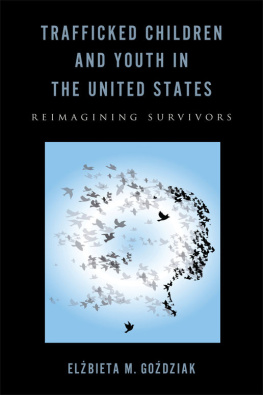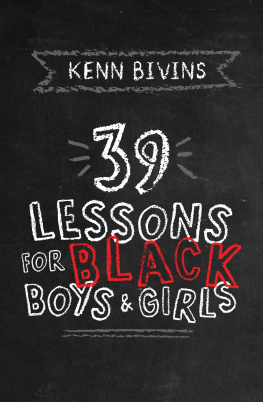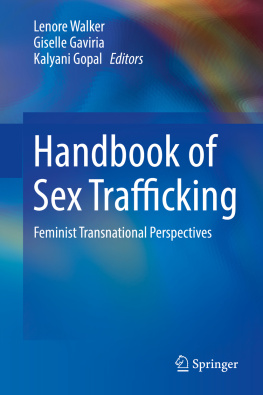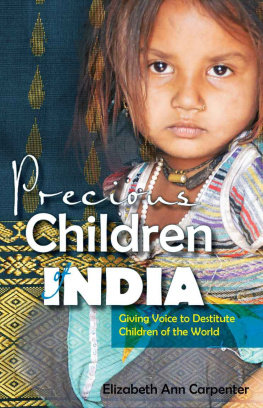Trafficked Children and Youth in the United States
The Rutgers Series in Childhood Studies
The Rutgers Series in Childhood Studies is dedicated to increasing our understanding of children and childhoods, past and present, throughout the world. Childrens voices and experiences are central. Authors come from a variety of fields, including anthropology, criminal justice, history, literature, psychology, religion, and sociology. The books in this series are intended for students, scholars, practitioners, and those who formulate policies that affect childrens everyday lives and futures.
Edited by Myra Bluebond-Langner, Board of Governors, Professor of Anthropology, Rutgers University, and True Colours Chair in Palliative Care for Children and Young People, University College London, Institute of Child Health.
Advisory Board
Perri Klass, New York University
Jill Korbin, Case Western Reserve University
Bambi Schieffelin, New York University
Enid Schildkraut, American Museum of Natural History and Museum for African Art
Trafficked Children and Youth in the United States
Reimagining Survivors
Elbieta M. God z iak

Rutgers University Press
New Brunswick, New Jersey, and London
Library of Congress Cataloging-in-Publication Data
Godziak, Elbieta M., 1954- author.
Trafficked children and youth in the United States : reimagining survivors / Elbieta M. Godziak.
pages cm.(The Rutgers series in childhood studies)
Includes bibliographical references and index.
ISBN 9780-813569703 (hardcover : alk. paper)ISBN 9780-813569697 (pbk. : alk. paper)ISBN 9780-813569710 (e-book (web pdf) : alk. paper)ISBN 9780-813575698 (e-book (epub) : alk. paper)
1. Child traffickingUnited States. 2. Child prostitutionUnited States. 3. Child prostitutesRehabilitationUnited States. I. Title
HQ144.G779 2016
306.745dc23
2015028622
A British Cataloging-in-Publication record for this book is available from the British Library.
Copyright 2016 by Elbieta M. Godziak
All rights reserved
No part of this book may be reproduced or utilized in any form or by any means, electronic or mechanical, or by any information storage and retrieval system, without written permission from the publisher. Please contact Rutgers University Press, 106 Somerset Street, New Brunswick, NJ 08901. The only exception to this prohibition is fair use as defined by U.S. copyright law.
Visit our website: http://rutgerspress.rutgers.edu
Contents
Authors, like Oscar winners, are often advised to keep their acknowledgments short. However, where a book project based on several years of field research is concerned, very many people contributed to the endeavor. I would like to express my gratitude to all of them.
First, many warm thanks to my research team members: Micah N. Bump, Julianne Duncan, Margaret MacDonnell, and Mindy Loiselle. Without them the original study that gave birth to this book would have never been possible.
My deepest gratitude goes to the U.S. Conference of Catholic Bishops and the Lutheran Immigration and Refugee Services for facilitating access to the survivors of child trafficking and their caseworkers and indulging my never-ending questions. Sr. Mary Ellen Dougherty, Juliane Duncan, and Nathalie Lummert of USCCB were particularly instrumental in getting me into the field of child trafficking. At LIRS, Annie Wilson and Chak Ng were also indispensable to paving my way into the assistance programs for trafficked minors.
Two friends and colleagues, Marisa O. Ensor of the University of Tennessee and Anahi Viladrich of the City University of New York read an earlier version of the manuscript and provided invaluable recommendations to strengthen this book. I am very grateful for their frank assessments.
I am particularly indebted to Marlie Wasserman, my editor at Rutgers University Press, and her team for their enthusiastic support of this project. I would also like to thank the anonymous reviewers who critically evaluated my book proposal and provided invaluable advice to improve the text.
This research would have not been possible without the financial support of the National Institute of Justice. NIJ financed the original study that spearheaded this research and has continued to support several of my forays into human trafficking research. Along the way I worked with outstanding project officers at NIJ: Jennifer Handley, Karen Bechar, Maureen McGough, and John Picarelli. I would like to thank them all for their enthusiastic support of my research agenda on human trafficking.
Heartfelt thank you to the Rockefeller Foundation for supporting my residency at the Bellagio Center in Italy where the book prospectus took shape.
Many thanks to my research assistantsSara Graveline, Whitney Skippings, and Minna Songwho masterfully copyedited and formatted this book. Special thank you goes to Michael Sliwinski who helped me wordsmith this text and corrected the nonnative English speakers quirky ways of expressing herself.
The real heroes of this effort are the survivors of child trafficking! Thank you from the bottom of my heart!
Afong Means Strength
It was a crisp fall afternoon in 2013. I was waiting in front of the Silver Diner in suburban Maryland to meet Evelyn. Several years older than when I first interviewed her, Evelyn has not lost her exuberance. Pushing her ten-month-old son in a stroller to the restaurant where we planned to have a late lunch, Evelyn smiled and waved as soon as she spotted me. With one hand holding onto the babys carriage, she used her other arm to envelop me in a warm hug.
Evelyn is a survivor of domestic servitude. For two years she lived in her traffickers house in Greenbelt, Maryland, completely isolated from outside contact. She was not permitted to speak with her family, go to school, or even answer the door. In 1995, Evelyns mother and uncle sold her to Theresa Mubang, an acquaintance of Evelyns maternal uncle, to settle an old land dispute in Cameroon. Mubang brought Evelyn to the United States when she was barely ten years old. Mubang, a naturalized U.S. citizen, traveled on an American passport, but Evelyn used fraudulent documents to cross international borders. Evelyn thought she was coming to the United States to fulfill her childhood dream of attending an American school, but the reality was different from the life she imagined watching The Cosby Show and The Fresh Prince of Bel Air. Instead of the idyllic life of hopping on a school bus every morning, learning English, and making new friends, Evelyn was forced to care for Mubangs young children around the clock and perform never-ending household chores. When she was allowed to rest, she slept on the floor. If her cleaning was not up to Mubangs standards, Evelyn was beaten with an extension cord or locked up in a basement without food. Mubangs son urinated on Evelyn regularly to humiliate her. When she tired of beating Evelyn, her captor scratched the girl. If ever there was a poster child for a trafficked minor, Evelyn is it.
Evelyns body testifies to the physical violence she endured: she has scars and burns to remind her of the ordeal. A decade after she escaped, it is still difficult for Evelyn to recount not just the scars on her body but also the verbal abuse Mubang wielded as skillfully as the rod she used to discipline her. However, the insults, the cruelty, and the violence did not squash Evelyns spirit. Throughout her ordeal Evelyn refused to give up. She persisted, day by day, with a defiantly hopeful outlook and a head held high.
When the opportunity arose, Evelyn escaped. She found help, first from a distant relative and then from Lutheran Immigration and Refugee Services. In 2003, when Evelyn was nearing her thirteenth birthday, the U.S. government officially recognized Evelyn as a trafficked child. She was now eligible for federally funded assistance to victims of child traffickinghelp was on its way. Evelyn is grateful to Lutheran Immigration and Refugee Services, to her foster auntie, and especially to her pro bono attorney, Melanie Orhant. With Orhants expert legal assistance, Evelyn received a special visa for victims of trafficking (T-Visa) that allowed her to stay in the United States, be placed in foster care, and attend school. Throughout this lengthy process, Evelyn observed Orhant, who at the time was a managing attorney for the Break the Chain Campaign, helping other victims rebuild their lives in America. Melanies passion and dedication inspired Evelyn. During our first interview in 2006, Evelyn told me she wanted to be like Melanie: to advocate on behalf of trafficked victims, participate in antitrafficking activities, and lead support groups for survivors. Truth be told, I was a bit skeptical about her ability to accomplish her goals. Evelyn has proven me wrong; she has achieved her dream of becoming a self-described activist against modern-day slavery. Evelyn speaks at events for the Break the Chains Campaign and collaborates with Survivors of Slavery, a nonprofit organization, which supports survivors of modern slavery who want to lend their voice to the 21st century abolitionist movement. Recently, Evelyn went on a retreat with a group of young women who had been trafficked for sexual exploitation. She said that she drew strength from the retreat and hoped that sharing her story was helpful to the other women.














